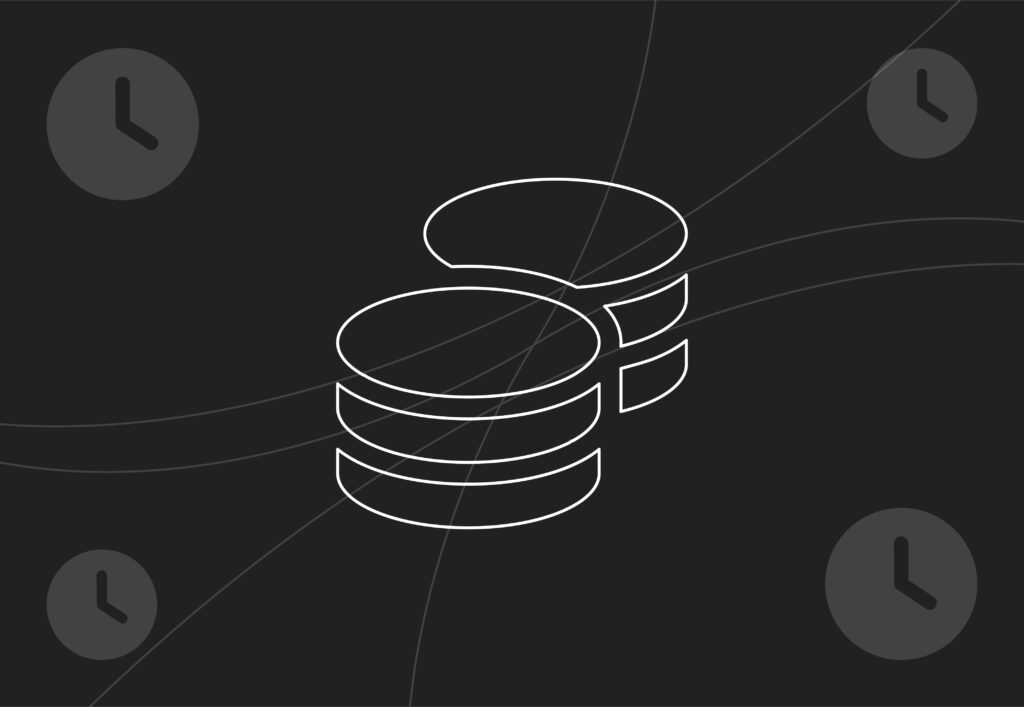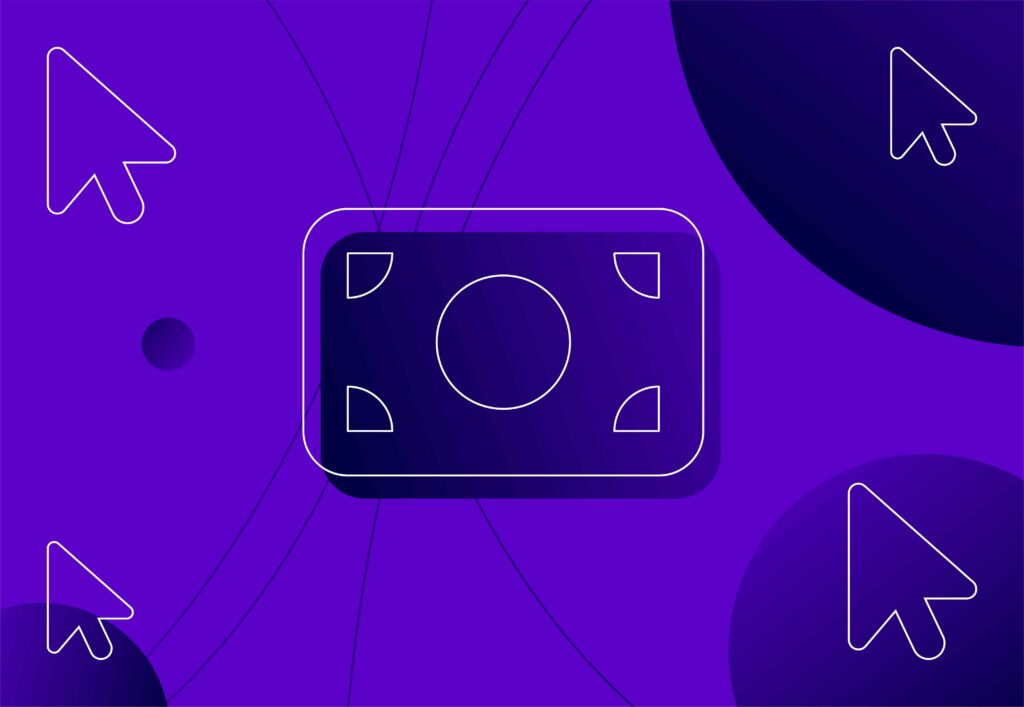
Paid social basics explained

Are you new to the digital marketing space and thinking, “What is paid social?”
In the paid media world, paid social is a great way to deliver top-of-funnel interest, such as brand awareness, and even build a social following. However, there is also the capability to drive conversions and leads. Paid social uses social media channels to display advertising content to a targeted audience interested in your product or services.
Paid social advertising can appear in several formats and channels. Format-wise, you can expect to see images, videos, carousels and more–which are typically shown as “sponsored” or “promotion” when you scroll past them on your feed. Paid social ads fit seamlessly into the algorithm, mimicking the look of organic social media content on the platform. By blending these ads into the user experience, they drive higher engagement and a better ROI.
Image ads
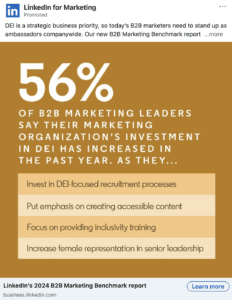
One of the most popular ad formats, image ads include a single photo, ad copy (including primary text and a headline), and a clear call to action (CTA). They can include graphics, individual images, or even collages. The world is your oyster when it comes to crafting eye-catching content for your brand–just ensure that you stand out.
They’re used to promote a product or service and encourage users to take action, such as “shop now” or “learn more.”
Video ads
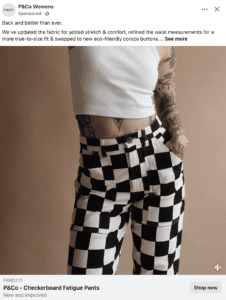
Video has become more prominent than ever in recent years, largely due to TikTok. These types of ads are highly engaging, immersive and great for capturing an audience’s attention. Utilising videos can foster trust and can help brands share a clear message in an easy-to-digest format.
Catalogue ads
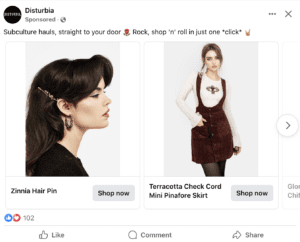
There are different variations in catalogue ads. Some may look like the example below, showcasing products from a website’s feed; others may include an intro card featuring a single image before a carousel, while some may be a single stand-alone image that directs to a product page.
These types of ads are brilliant for sales campaigns. They showcase your products and direct users to a specific page while also serving as an excellent tool for retargeting customers who have already visited your site but have not completed their journey.
Influencers

Some ad types may not be as obvious as others. Influencer ads are an easy way to promote your brand seamlessly. For many brands, influencer outreach is essential as it enables you to harness the trust and loyalty that an influencer has developed with their established audience.
These ads typically work in two ways. Either a brand pays an influencer to promote their product or service. Alternatively, an influencer can include an affiliate link or promo code to make a purchase. Either way, the influencer must be entirely transparent about whether their post is an advertisement; otherwise, they and the brand may face consequences.
Paid social is similar to organic social media, yet some key differences exist. Simply put, they are different types of posts appearing on a specific social media platform.
- Paid social content has a monetary spend behind it, helping reach wider audiences likely to be interested in a product or service. Paid social ads can drive leads, conversions, traffic and more.
- Organic social refers to content shared for free on a platform–anyone can do it. Organic social posts immediately reach your existing audience, but no targeting options exist to increase that pool. However, social media platforms may show posts to a wider network based on the algorithm.
Most social media channels have their own advertising services. Meta, which serves ads on Facebook and Instagram, is the most popular amongst advertisers.
But why? Well, anyone can advertise on it!
Even if you’re a page admin or seasoned marketing professional, Meta has a range of marketing tools to help you reach your business goals, regardless of advertising experience.
With all that in mind, there are plenty of other social media channels that offer paid advertising services, including LinkedIn, Pinterest, TikTok, Snapchat, WhatsApp and even Reddit. Before you start running paid social ads, it’s imperative to understand where your business sits in the online space.
Agency vs in-house
For businesses, paid social advertising can be managed either in-house or through a dedicated marketing agency that specialises in paid social. Each option has its own advantages and drawbacks, depending on your resources and needs. Collaborating with agencies typically allows for greater flexibility and scalability compared to relying solely on an in-house team. Not only that, but agencies have teams with diverse skill sets that can help your paid social strategy integrate seamlessly with your other marketing efforts.
But does paid social work, and how would you incorporate it into your strategy if you’ve never used it before? We’ve put together the basics, covering everything you’ll need to know before diving headfirst into the world of paid social.
Navigating paid social platforms, and the strategy across them can be a bit of a minefield, regardless of whether your business is well-established, or it’s brand new. From what your aim is, to who you want to serve ads to and what you want those ads to look like, there’s a lot to consider before jumping straight into spending on the likes of Meta, Linkedin, TikTok and Pinterest.
Below, we’ve outlined the key steps you need to take in order to run effective campaigns across these platforms, so you can get the most out of both your advertising budget and efforts.
1. Outline your objectives
From brand awareness to increasing traffic, driving conversions or generating leads, paid social platforms have all manner of objectives to support your overall business objectives. It’s important, before you do anything else, to understand exactly which of these objectives fit best with your overall goal.
The key paid social objectives are:
- Brand awareness: for brand-new businesses, or those with little digital presence, it might be wise to start with brand awareness campaigns where for a low cost, you can reach large quantities of users and simply get your brand in front of them.
- Engagement: paid social can support organic social by encouraging users to visit your social pages or get them to like and comment on your content.
- Traffic: whether it’s to sending users a specific landing page to encourage action, or simply sending them to a blog page to educate them, the power of traffic is unmatched. Not only can you reach large audiences and get them to visit your website for a low cost, but you can also effectively nurture and encourage conversion further down the purchase journey via retargeting.
- Lead generation: if your business requires customer data, or you need users to download your content like guides, resources and forms, you may want to consider lead gen as a tactic.
- Conversion: conversion objectives across paid social platforms can vary in metrics, but whether you want to encourage users to add to their basket so you can retarget them across your advertising activity, or you simply want them to make the purchase there and then, paid social can work well with e-commerce brands to generate revenue from sales.
2. Understand your audience
Who do you want to be targeting with your paid social activity? Paid social is known for being a key channel for finding new users due to its large reach potential and whilst targeting approaches like Advantage+ on Meta encourage targeting these broad audiences, you still need to know what your customer looks like, how they shop your products or interact with your business and where you might best find them.
Creating personas might be helpful for small, new businesses to understand more about their ideal customer’s behaviour. Then, you can begin to look at the different targeting approaches.
For example, interest targeting can still help you target large audiences, but ensure that those who see your ads, have relevancy to what you’re advertising. Lookalike audiences use existing data or your website visitors’ behaviour to find users online that behave in a similar way, or have similar demographic information.
If you’re already working across other digital channels and see strong success with your site performance, you may want to look straight into retargeting these users.
3. Find the right platforms
Often, businesses choose the platform they want to be on as the first step when looking to advertise on social media, but without understanding your objective and audiences first you may find you’re looking in the wrong direction.
LinkedIn, for example, is typically best suited for businesses looking to target professionals or specific industries, whilst Facebook and Instagram see great success with e-commerce businesses thanks to their dynamic shopping approaches that can support other channels like PPC’s Google Shopping. Pinterest advertising is also a great way for brands to connect with audiences who are looking for inspiration.
4. Determine budgets
Once you have an idea of what you want to use paid social for, who you want to target and which platforms are right for your business’s strategy, you will have a much better view of how far your paid social budget will stretch. Limiting yourself with budget from the start will only stunt the performance of your campaigns. Alternatively, putting all your spending into one platform can jeopardise too, if the campaigns aren’t being optimised correctly once live.
So now you know the initial details you need to set up a paid social campaign and get your ads running across the platforms. However, the work doesn’t end there, as keeping up to date with said platforms and their ever-changing approaches is important to ensure your activity doesn’t run dry and waste your hard work and budgets.
Below are some of the key optimisations our paid social team believes you should be making across campaigns to keep them as efficient as possible:
- Creative: creative fatigue happens when your ad has been served too many times, for too long, by the same users. Looking at metrics like frequency and click-through rates can help understand whether an ad needs switching out or if your creative is actually working.
- Audience testing: all too well advertisers find an audience that works and stick with it, not taking into account additional audiences that might work even better. By regularly testing new audience types you’re fuelling your campaigns with the best targeting approaches.
- Trying new objectives: likewise, advertisers often have one goal in mind and stick to it. By trying new objectives like traffic and conversion, or testing an add-to-cart metric over conversion, you’re gaining insight into how your users interact and guiding them through your customer journey more efficiently.
You may be wondering if paid social media is “worth it.” Like SEO or PPC, social media is a marketing channel that helps build a stronger overall funnel. When it comes to organic versus paid, it’s not about which one to choose; it’s important to support your paid campaigns with your organic social efforts.
A key part of the funnel
Social media marketing is a very TOF channel; however, when used correctly, it can contribute to the whole funnel and aid other channels. First and foremost, paid social increases brand awareness and can drive traffic to your website, ultimately providing valuable audience insight that can be used to optimise campaigns for other marketing channels. A strong, well-established social media strategy considers the wider picture, be it using paid social media to amplify your organic social efforts or regularly checking in with the PPC team to optimise strategy more effectively. A marketing team that doesn’t talk to each other is never beneficial!
Guaranteed reach
This is a big one. Organic social can only get you so far, but putting spend behind your content ensures it gets seen. The social media algorithm is ever-changing, and watching the post you spend hours cultivating flop can be infuriating. With paid social, you are paying for your audience’s full attention, and properly optimised ads can lead to significant results. Considering 28% of consumers discover new products directly through social media, it’s a great way to introduce your brand to new customers and grab the attention of existing ones without being restricted by the algorithm.
Audience insights
Paid social can also uncover hidden insights for your audiences. For campaigns such as traffic and sales, you can explore various audiences to determine if there’s interest in those areas. This information can be shared with other marketing channels for testing or utilised in future paid social campaigns to reduce CPA.
With this in mind, there isn’t a one-size-fits-all solution to curating a fully optimised paid social media strategy. This is achieved with a strong marketing team, clear objectives and an understanding of which channels are best for your business.
If you’re looking to include social media in your marketing strategy, then Embryo can help. We pride ourselves on staying ahead of the curve, especially when it comes to new updates in the paid media space. Get in touch with our paid social media team for a bespoke strategy that can help you achieve your business goals.
Call us on 0161 327 2635 or email our team at info@embryodigital.co.uk.


